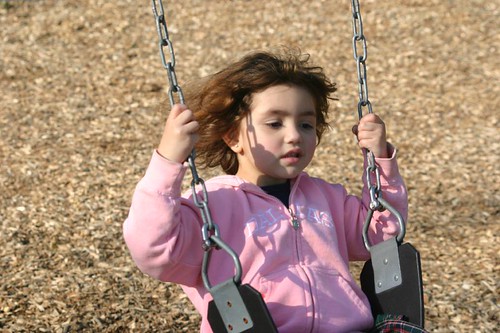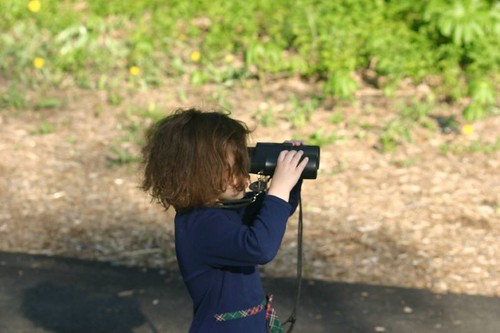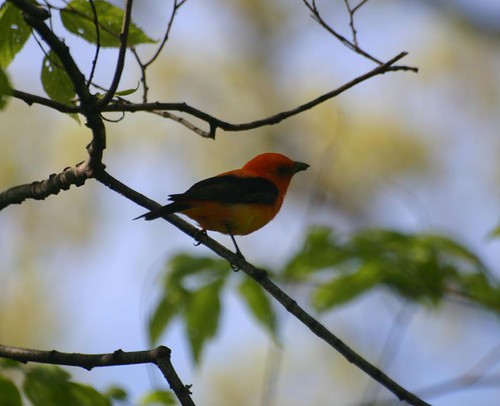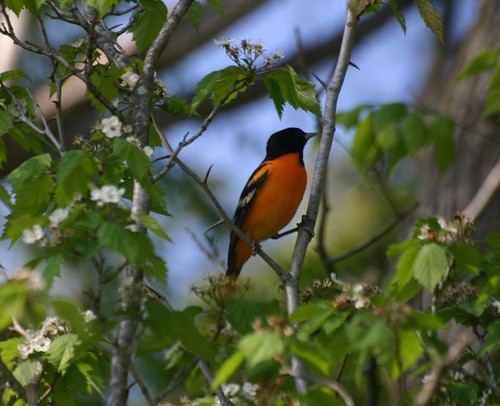Posted by: Ken @ 1:45 pm
This path in Hawk’s Bluff Park was warbler-rich:
An astronomer defines spring rather precisely. In the Northern Hemisphere, spring begins with the vernal equinox, usually March 21, and ends with the summer solstice, usually June 21. In South Florida, spring, as defined by the appearance of flowers on the trees, starts creeping up around early February, and ends with the rains of June and July. Ask a birder when spring migration begins, and you will get many answers, depending on where the birder lives and her particular interests. In temperate areas, raptors begin arriving in early March. Flocks of swallows may be seen in April. When I visited the Arctic tundra during the first week of June, many shorebirds were just arriving on their nesting grounds.
To me, here in Illinois, as in my childhood home of New Jersey, spring means the time of arrival of flocks of warblers. I remember them coming in just as the tree buds began to burst open in early May. Myrtle Warblers (as we called the eastern race of theYellow-rumped species) appeared earlier, as if to increase our sense of anticipation of the other species. The trees leafed out during the next couple of weeks, and the warblers became more elusinve, and finally disappeared.
The older granddaughter enjoys the swing sets at Hawk’s Bluff Park, to be dedicated this Saturday:
As she studied a Robin through my binoculars, she exclaimed: “These make my eyes really big!”

A new city park is opening near us, along Mill Creek in Batavia, Illinois. Called Hawk’s Bluff Park, it has been a pretty good migrant trap. We mentioned our first visit in our May 2 post (the Canada Goose at the overlook is still incubating). During brief visits the past few days we have seen a surprising number of bird species. Aside from the common resident birds, we have been treated to 4 Vireo species (Blue-headed, Warbling, Red-eyed, Yellow-throated), 4 flycatchers (Eastern Kingbird, Eastern Phoebe, Eastern Wood-Pewee, Great Crested Flycatcher), 4 woodpeckers (Red-bellied, Red-headed, Downy, Northern Flicker), Swainson’s Thrushes, Baltimore Orioles, Rose-breasted Grosbeaks, Scarlet Tanagers, and 9 warbler species (Yellow-rumped, Yellow, Nashville, Black-throated Green, Chestnut-sided, Blackburnian, Magnolia, Black-and-White, American Redstart). Nearby, we also saw Blue-winged Warblers and Common Yellowthroats.
Warblers are getting harder for me to see. Yes, cataracts are forming, and floaters are darting around, but it is not only a matter of dim vision. With climate change and degradation of tropical wintering and boreal breeding habitats, many warbler species are becoming scarce. As measured by the blooming of shrubs and trees, spring has actually been arriving in the northern half of the United States about 8 hours earlier each year since 1982. The trees are leafing out sooner, giving the warblers better hiding places. This all adds up to a spring that seems now to be much shorter than those of my youth.
In a sense, this Illinois spring has been one of my longest in recent memory. We have lived in the southern and southwestern states for over forty years. A few times we have made quick spring trips to Cape May or northern New Jersey at about the right time, to enjoy a day or two of warbler watching, sandwiched between visits to family and friends. This spring has been different. We arrived here in mid-April. There are easily accessible birding habitats which, despite the limitations imposed by weather, family and social obligations, have provided us with almost daily opportunities for an hour or two of birding. Now it must end abruptly, not only because the forest canopy is closing in, but because we must return to Florida for a while.
Don’t get me wrong– I don’t hate Florida. In fact, the winters are delightful, and the Everglades are right at hand. What I miss in Florida is the drama of seasonal change. I still have a snow shovel hanging in the garage. There has not been a measurable snowfall in our area. In fact, the only time snow was ever seen was on January 19, 1977, at about 7 a.m. EST, when a few flurries were reported around Miami. However, my snow shovel has come in handy as a dust pan a few times when I swept out the garage or patio.
This Scarlet Tanager has its usual bright red plumage replaced by bright orange. At first I thought it was an oriole of some sort, but quickly noticed that the heavy bill and lack of wing bars characterize it as a Scarlet Tanager. The Sibley guide illustrates this color variant:

Properly orange Baltimore Oriole:
BONUS FROM GRANDPA: Las dos Nietas riding ponies on their joint (3rd and 4th) birthday party:















May 16th, 2008 at 7:14 am On Thu, 15 May 2008 20:02:11 -0700 (PDT), Mary Ann Barnwell, SC kindly wrote (on rec.birds):
“I enjoy your blog. the pictures are great. I have a grandson who will be two in June and I keep wondering how soon can I give him his first binoculars and bird book. I want my grandson to have big eyes too.”
May 19th, 2008 at 5:11 pm Article in the Daily Herald this weekend:
New Batavia park is for the birds — and residents
Batavia Park District celebrated the opening of its newest facility Saturday with a presentation on native birds of prey. It was fitting for the new 30-acre park, which is named Hawk’s Bluff.
“There are three hawks that nest in this area and we want to keep them here,” said James Eby, director of planning and development for Batavia parks.
Hawk’s Bluff is at 950 Twin Elms Lane, nestled far enough within the Tanglewood Hills subdivision to be free of traffic noise and offer a sense of being able to get away from it all for a while. The subdivision is just west of Randall Road and south of Main Street…
…[The park’s] most unique quality is its natural beauty. According to Eby, Hawk’s Bluff is home to four eco-systems that include a prairie, stream, wetlands and oak savannah trees that may be 165 years old, according to an arborist. “This is what it looked like in pre-settlement times,” Eby said. [MORE]
<http://www.dailyherald.com/story/?id=193057>